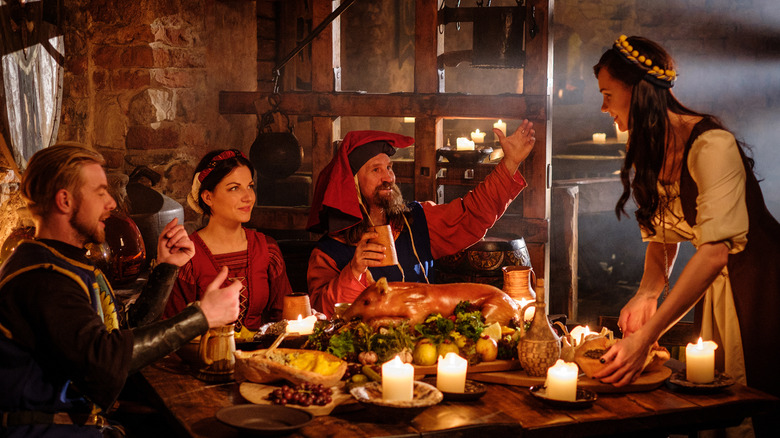The Strange Meal Wealthy People Ate During Medieval Times
The medieval period in Western Europe was a really weird time: animals were put on trial, wars were fought by literal children, and soccer was played by kicking around a bladder. Perhaps unsurprisingly, the food from this period of famine and pestilence sounds disgusting. Though serfs and other poor people from this time ate a diet somewhat recognizable to modern tastes — porridge, preserved and pickled foods, bread — the rich diets of the wealthy were often faddish and bizarre (via British Library).
Wealthy diners avoided fresh fruits and vegetables, believing them disease-ridden (or, as one cookbook put it, "Beware of green sallettes and rawe fruytes for they wyll make your soverayne seke"). On certain religious days, such as during Lent, rich people weren't allowed to eat dairy or meat, leading to the invention of creative substitutes, such as "hard-boiled eggs" made from almond paste, according to the British Museum. Diners often drank alcohol instead of water, believing it to be more nutritious (via Medieval Britain). And when grain in the Middle Ages spoiled, it would sometimes sprout a fungus that made people hallucinate, similar to LSD (via Buzzfeed).
But all of that sounds positively scrumptious compared with what seems like one of the questionable meals medieval England had to offer.
Haggis, but somehow worse
To this day, haggis is the national dish of Scotland (via Britannica). It's a savory pudding of seasoned sheep organs and oatmeal boiled in a sheep's stomach, and though your stomach may turn at that description, many people genuinely seem to enjoy it (via The Daily Meal).
Whether they would enjoy this 14th century variant on haggis is another matter. Taken from "The Forme of Cury," the oldest known cookbook written in English, the recipe is for "puddyng of purpaysse" — that is, porpoise pudding (via Buzzfeed). The recipe requires the blood, "grease," and stomach from a porpoise, as well as oatmeal and some simple spices. The blood and grease are combined with the oatmeal, salt, pepper, and ginger, and stuffed in the stomach for boiling (via Gode Cookery).
Surely, you may think, no one actually ate such a thing. Unfortunately, it's likely they did, at least at the very top of British society: the cookbook was written by Richard II's chefs, who wrote the book as a means to teach cooks "everyday" recipes and special treats for banquets, according to the British Library. The text also includes recipes for cooking up whales, cranes, curlews, herons, and seals. Medieval cooks could have made quite a feast out of the London Aquarium.

